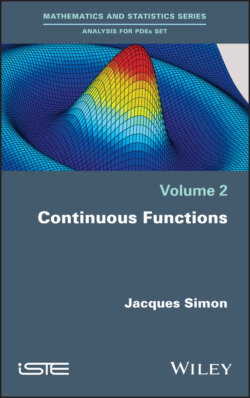Continuous Functions

Реклама. ООО «ЛитРес», ИНН: 7719571260.
Оглавление
Jacques Simon. Continuous Functions
Table of Contents
List of Illustrations
Guide
Pages
Volume 2. Continuous Functions
Introduction
Notes
Familiarization with Semi-normed Spaces
Notations. SPACES OF FUNCTIONS
OPERATIONS ON A FUNCTION f
DERIVATIVES OF A FUNCTION f
INTEGRALS AND PATHS
SEPARATED SEMI-NORMED SPACES
POINTS AND SETS IN ℝd
OTHER SETS
SPECIAL FUNCTIONS
TYPOGRAPHY
Chapter 1. Spaces of Continuous Functions
1.1 Notions of continuity
1.2 Spaces С(Ω; E), Сb(Ω; E), СK(Ω; E), С(Ω; E) and Сb(Ω; E)
1.3 Comparison of spaces of continuous functions
1.4 Sequential completeness of spaces of continuous functions
1.5 Metrizability of spaces of continuous functions
1.6 The space
1.7 Continuous mappings
1.8 Continuous extension and restriction
1.9 Separation and permutation of variables
1.10 Sequential compactness in Cb(Ω; E)
Notes
Chapter 2. Differentiable Functions
2.1 Differentiability
2.2 Finite increment theorem
2.3 Partial derivatives
2.4 Higher order partial derivatives
2.5 Spaces and
2.6 Comparison and metrizability of spaces of differentiable functions
2.7. Filtering properties of spaces of differentiable functions
2.8. Sequential completeness of spaces of differentiable functions
2.9. The space and the set
Notes
Chapter 3. Differentiating Composite Functions and Others
3.1. Image under a linear mapping
3.2. Image under a multilinear mapping: Leibniz rule
3.3. Dual formula of the Leibniz rule
3.4. Continuity of the image under a multilinear mapping
3.5. Change of variables in a derivative
3.6. Differentiation with respect to a separated variable
3.7. Image under a differentiable mapping
3.8. Differentiation and translation
3.9. Localizing functions
Notes
Chapter 4. Integrating Uniformly Continuous Functions
4.1. Measure of an open subset of
4.2. Integral of a uniformly continuous function
4.3. Case where E is not a Neumann space
4.4. Properties of the integral
4.5. Dependence of the integral on the domain of integration
4.6. Additivity with respect to the domain of integration
4.7. Continuity of the integral
4.8. Differentiating under the integral sign
Notes
Chapter 5. Properties of the Measure of an Open Set
5.1. Additivity of the measure
5.2. Negligible sets
5.3. Determinant of d vectors
5.4. Measure of a parallelepiped
Chapter 6. Additional Properties of the Integral
6.1. Contribution of a negligible set to the integral
6.2. Integration and differentiation in one dimension
6.3. Integration of a function of functions
6.4. Integrating a function of multiple variables
6.5. Integration between graphs
6.6. Integration by parts and weak vanishing condition for a function
6.7. Change of variables in an integral
6.8. Some particular changes of variables in an integral
Notes
Chapter 7. Weighting and Regularization of Functions
7.1. Weighting
7.2. Properties of weighting
7.3. Weighting of differentiable functions
7.4. Local regularization
7.5. Global regularization
7.6. Partition of unity
7.7. Separability of K∞(Ω)
Notes
Chapter 8. Line Integral of a Vector Field Along a Path
8.1. Paths
8.2. Line integral of a field along a path
8.3. Line integral along a concatenation of paths
8.4. Tubular flow and the concentration theorem
8.5. Invariance under homotopy of the line integral of a local gradient
Notes
Chapter 9. Primitives of Continuous Functions
9.1. Explicit primitive of a field with line integral zero
9.2. Primitive of a field orthogonal to the divergence-free test fields
9.3. Gluing of local primitives on a simply connected open set
9.4. Explicit primitive on a star-shaped set: Poincaré’s theorem
9.5. Explicit primitive under the weak Poincaré condition
9.6. Primitives on a simply connected open set
9.7. Comparison of the existence conditions for a primitive
9.8. Fields with local primitives but no global primitive
9.9. Uniqueness of primitives
9.10. Continuous primitive mapping
Notes
Chapter 10. Additional Results: Integration on a Sphere
10.1. Surface integration on a sphere
10.2. Properties of the integral on a sphere
10.3. Radial calculation of integrals
10.4. Surface integral as an integral of dimension d − 1
10.5. A Stokes formula
Notes
Appendix. Reminders
A.1. Notation and numbering
A.2. Semi-normed spaces. Vector spaces and semi-norms
Open, closed and bounded sets, sequences, connectedness
Compactness
The space ℝd, metrizable spaces, Fréchet spaces and Neumann spaces
A.3. Continuous mappings and duality. Continuous mappings
Linear or multilinear mappings
Dual and weak topology
A.4. Differentiable mappings and differentiable functions
Notes
Bibliography
Index. A
B
C
D
E
F
H
I
J, K
L
M
N
O
P
R
S
T
U
V, W
Other titles from. in Mathematics and Statistics. 2020
2019
2018
2017
2016
2015
2014
2013
2012
2011
2010
2008
2007
2006
WILEY END USER LICENSE AGREEMENT
Отрывок из книги
To Claire and Patricia, By your gaiety, “joie de vivre”, and femininity, you have embellished my life, and you have allowed me to conserve the tenacity needed for this endeavor
.....
— The concentration theorem for the integral and the construction of an incompressible tubular flow (Theorems 8.18 and 8.17), which are key steps in our construction of the primitives of a field taking values in a Neumann space, as it is explained in the comment Utility of the concentration theorem, p. 186.
Prerequisites. The proofs in the main body of the text only use definitions and results established in Volume 1, whose statements are recalled either in the text or in the Appendix. Detailed proofs are given, including arguments that may seem trivial to experienced readers, and the theorem numbers are systematically referenced.
.....